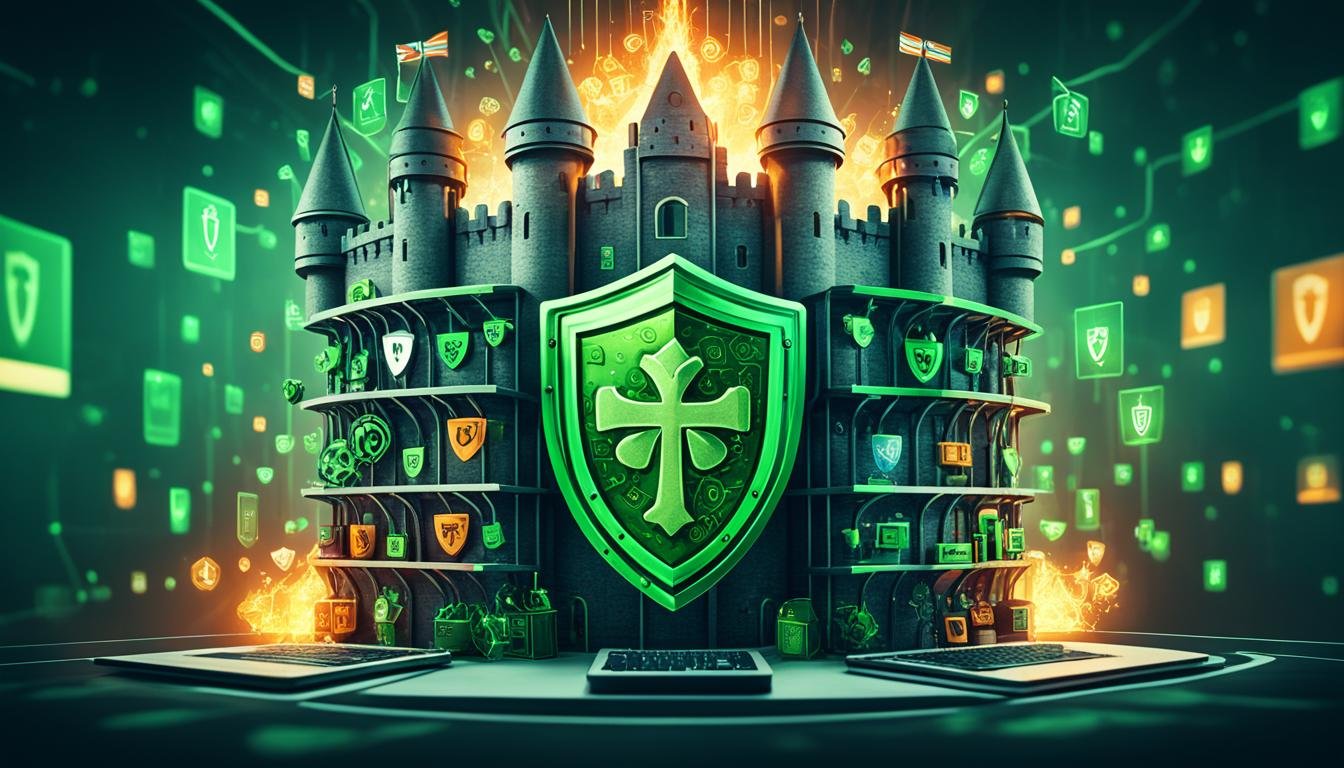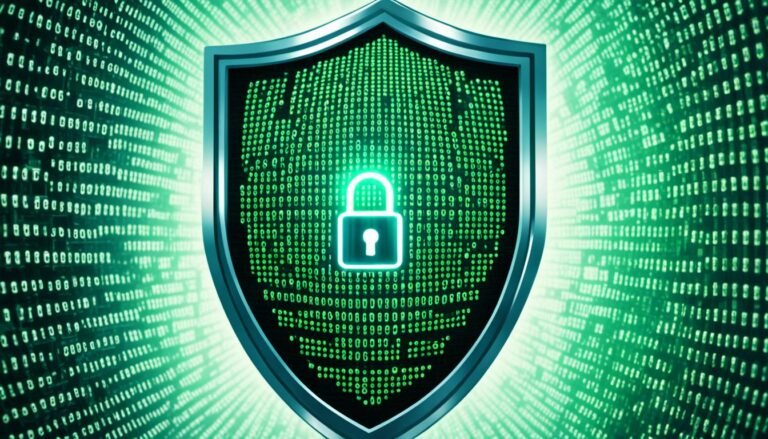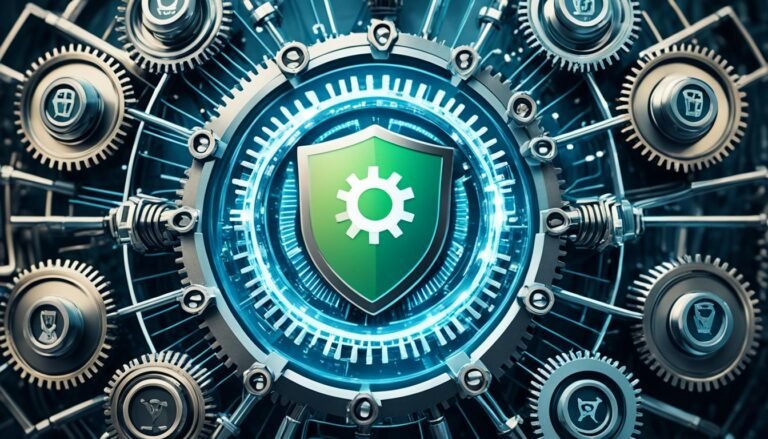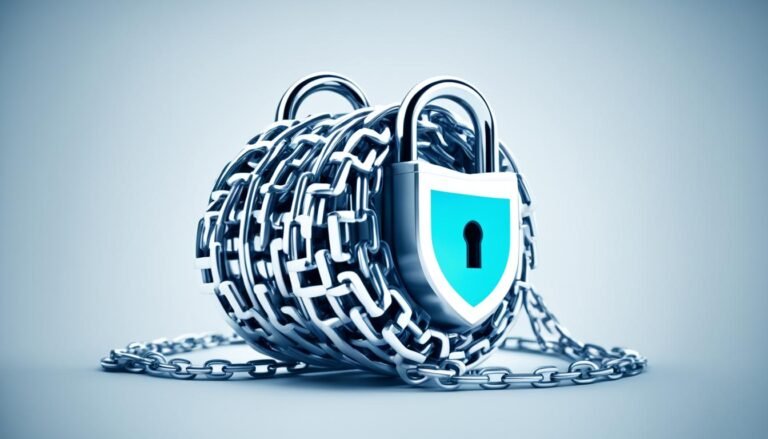Ransomware Defense: Strategies for Irish Organizations
Did you know ransomware attacks happen every 11 seconds? This shows how fast threats hit Irish groups. Ransomware harms firms financially and hurts their name. To fight these threats, using the best tools and strategies is vital.
Now, Ireland needs strong defenses against ransomware more than before. Strong cyber strategies and special tools can ramp up protection. Cynet 360 stops threats at many levels, protecting companies from ransomware attacks.
Also, using protections in systems like Windows 10 can make you safer. Windows 10 stops ransomware by only letting safe apps change files. This cuts down on risks beautifully.
Key Takeaways
- Ransomware attacks happen every 11 seconds, underlining the importance of proactive defense for Irish organizations.
- Effective ransomware protection in Ireland involves a combination of anti-ransomware tools and robust cybersecurity strategies.
- Cynet 360 provides comprehensive defense mechanisms, including propagation blocking and threat intelligence.
- Windows 10 ransomware protection enhances security by allowing only approved applications to alter the file system.
- Combining multiple layers of defense can significantly reduce the risk of ransomware attacks.
- Adopting a strong defense approach can save organizations from financial and reputational damage.
Understanding Ransomware and Its Impact on Irish Businesses
Ransomware poses a big threat to businesses today, especially in Ireland. Cybercriminals use advanced methods like sending fake emails, finding weaknesses in firewalls, and exploiting flaws in remote systems. After infecting a computer, ransomware locks files and asks for money, usually in a way that’s hard to trace.
The Conti ransomware, associated with a group called Wizard Spider, shows why Ireland needs strong cybersecurity. Attacks on big targets like the Irish Health Service Executive and the Colonial Pipeline have caused major problems and losses.
Companies are fighting back with tools like endpoint detection and response (EDR) systems. These use artificial intelligence to spot ransomware by its unusual actions. They’re also using services that provide up-to-date information on new ransomware threats.
Understanding how ransomware spreads is crucial. This can happen through bad email attachments, unsafe websites, or holes in software. There are different kinds of ransomware, but they all can hurt a business by causing financial loss, bad reputation, legal trouble, and stopping work.
Tools like decryptors from the No More Ransom project help lower the risk. This project, led by the police and tech companies, offers free tools to unlock files affected by ransomware. The goal is to avoid paying the ransom.
Some governments are making laws to punish companies that pay ransoms. The aim is to stop funding for ransomware criminals. Places like Ireland, with many nonprofit organizations and limited tech defenses, need extra help to protect their data.
To fight off ransomware, organizations should use many tactics together. Train employees, keep software up to date, use anti-malware, be careful with email attachments, set strong passwords, back up data often. Also, limit who can access sensitive information, and have a clear plan for when an attack happens.
Knowing and acting early is the best defense against ransomware in Ireland. Keeping up with security news and using strong safety measures can help companies avoid or deal with ransomware attacks.
Basic Cybersecurity Practices for Ransomware Protection
Irish companies should focus on key cybersecurity steps for ransomware safety. They need strong authentication, anti-malware tools, and enhanced network security. These are key to fighting off cyber attacks. By following these steps, the risk of ransomware is much lower.
Robust Authentication
Malware protection in Ireland starts with strong authentication. This means using hard-to-guess passwords and multi-factor checks. Continuous watching of who accesses data also helps keep it safe.
Anti-Malware Software
Next, having good anti-malware software is crucial. It finds and removes harmful software. It’s vital to keep these tools updated. This way, they can stop the latest ransomware threats.
Network Security Enhancements
Better network security is also a must. It stands guard and cuts down on threats. Firewalls, intrusion detection, and careful user access measures keep cybercriminals out. With the rise of Ransomware-as-a-Service, staying current is vital.
Improving network safety does more than just protect info. It keeps companies running smoothly. Updating regularly, backing up data, and having a solid response plan are crucial.
Dedicated Anti-Ransomware Solutions
Using dedicated cybersecurity tools for stopping ransomware can really boost safety. These days, attacks are getting harder to stop. So, it’s key to have the best tools to find and stop these dangers.
Multi-Layered Protection
Getting ransomware protection products like Cynet 360 gives full, layered defense. It protects your network, files, and apps. For example, BlackFog, used by over 500 groups, stops about 1000 threats every month. This shows how well it works.
Threat Intelligence
Knowing about threats is vital in advanced threat detection. Today’s tech uses info about threats to beat new malware and ransomware moves. This smart way can stop ransomware before it even starts, cutting a lot of the harm.
Financial Impact of Ransomware
| Year | Average Total Costs | Average Ransomware Demands |
|---|---|---|
| 2023 | $5.13 million | 43% Increase |
| 2021 | $1.85 million | REvil’s $50 million |
| 2020 | US$761,106 | $100 million by REvil |
Sandbox and Decoy Files
Using sandbox areas and fake files is a new idea in security. It traps threats in a safe place, finding and stopping ransomware tricks first. BlackFog even lets companies check their ADX tool for free for a week. This can protect up to 25 devices.
Just using outer defenses like firewalls and proxies isn’t enough. The ransomware threat keeps changing. So, mixing smart detection and being ready to act fast is crucial. Any business, from healthcare to schools, needs these special tools to stay strong against cyber attacks.
Utilizing Operating System Protections
Using features in Windows 10 can greatly boost its security against ransomware. Technologies like controlled folder access stop risky apps from changing important files. This stops ransomware from locking your data away.
Over the years, ransomware attacks have grown in complexity. They used to be on disks but now spread through networks and demand cryptocurrency payments. The system to spread these attacks involves many parts, including targets, bad actors, and different kinds of ransomware. For businesses, updating Windows 10 is key. It keeps their defenses sharp against the latest ransomware threats.
Now, let’s look at how these protections work and why they matter:
- Regular Updates: Updates keep your system safe from ransomware’s tricks.
- Controlled Folder Access: It decides which apps can touch your important data.
- Built-in Antimalware: Windows Defender checks for threats all the time to stop them early.
Recent stats show that up to 50% of big companies faced ransomware in 2020. The Colonial Pipeline attack in 2021 shows how this can cause widespread trouble. Both the Irish healthcare system and Acer Inc. were hit hard by these attacks.
Fighting ransomware isn’t just about having the right protections. It’s also about training staff well and making sure they know how to spot and avoid threats. Plus, it’s vital to have a plan ready in case an attack happens. Combining these OS features with good training and a solid plan can help keep your data safe and your business running smoothly.
Here’s how Windows 10’s security features fit into a good ransomware defense plan:
| Security Feature | Benefit | Implementation |
|---|---|---|
| Controlled Folder Access | Stops hackers from encrypting your data | Turn it on in Windows Defender’s settings |
| Regular Updates | Makes your system safer by patching holes | Set updates to happen automatically in Windows Update |
| Built-in Antimalware | Catches threats before they can do harm | Scan your system often with Windows Defender |
The Role of Decryptors in Ransomware Recovery
When efforts to prevent ransomware fail, decryptors become key in unlocking data. Shockingly, a global survey found less than a third of adults know what ransomware is. This shows the need for learning how to use decryptors properly.
Identifying Ransomware Type
The first step after a ransomware attack is figuring out the type. Tools like Crypto Sheriff help by narrowing down the ransomware family. This is essential before trying any recovery tools. Knowing the type helps use the correct decryptors, increasing success chances.
Using Legitimate Decryptors
After identifying the ransomware, finding a legit decryptor is next. The No More Ransom Project has many trusted decryptors. These are made by cybersecurity experts. They help unlock data without paying the ransom. Despite high demands like the $19 million from the Health Service Executive (HSE) in Ireland, these tools save money and reduce risks.
Limitations of Decryptors
Decryptors have limits too. Some ransomwares don’t have a matching decryptor. This means not all data can be recovered. Even if a ransom is paid, around 65% of the data can be recovered on average. Also, it might take up to a year to fully recover. So, it’s crucial to have a strong plan ready.
Organizations need to check and update their response plans regularly. Being ready can really help in a ransomware attack.
| Metrics | Statistics |
|---|---|
| Organizations targeted by ransomware by 2025 | 75% |
| Average recovery costs by 2025 | $1.85 million |
| Data restored after ransom payment | 65% |
| Bitcoin ransom payments since 2018 | $5.2 billion |
To fight against ransomware, it’s crucial to know how to use decryptors effectively. Also, always improving your cybersecurity measures can lessen the impact of an attack.
Employee Cybersecurity Training in Ireland
Employee cybersecurity training in Ireland is very important. It helps protect companies from cyber threats. These training programs focus on ransomware and phishing. They teach employees to spot threats and respond correctly.
Importance of Awareness
Being aware is key to fighting cyber threats. Many in Dublin, 40% of internet users, have been victims of phishing. Companies in Dublin are spending a lot on cybersecurity. But, without employees knowing about the dangers, this may not be enough.
Phishing Email Detection
Protecting against phishing is crucial as it’s very effective. Ransomware awareness includes spotting suspicious emails. Realistic email training can cut down on phishing risks significantly.
Remote Work Precautions
Remote work needs strong security measures. Employees must learn secure practices to keep sensitive data safe. Constant monitoring and advanced tools are crucial to quickly spot and stop cyber threats.
Implementing Network Security Measures
Boosting network security is crucial to stop ransomware and keep networks safe. Improving network security in Ireland makes it hard for ransomware to get in. These steps help spot and stop threats, making sure businesses’ digital areas stay safe.
Firewalls
Firewalls are like guards at the door, checking and controlling who comes in and goes out. Using strong firewalls, organizations can watch their data flow, keeping out unwanted visitors. This is key to block ransomware and keep network systems safe. It’s vital for companies to stay alert and update their firewalls to tackle new threats.
Intrusion Detection Systems
Intrusion Detection Systems (IDS) keep an eye on the network for any suspicious activity that might signal a ransomware hit. They sound the alarm fast, giving a chance to stop the threat before it does big damage. Having IDS is a smart move for network safety. It lets organizations keep a solid protection plan. With cyber threats on the rise due to events like the Russian invasion of Ukraine, IDS is more important than ever for network security in Ireland.
To wrap it up, blending firewalls and IDS is a must for strong ransomware prevention. These tools help Irish businesses fortify their defenses. They protect important systems and ensure a safe digital space.
Cloud Security for Irish Organizations
Irish organizations are moving towards cloud services more and more. They need to think carefully about security. The public cloud market in Dublin is set to almost double by 2027. But this growth also means more risks. Since 2021, there’s been a big 300% jump in cyber-attacks on the cloud. So, strong security is a must.
The key points of cloud security Ireland involve tight access controls, keeping data encrypted, and following safe cloud rules. These steps help stop ransomware threats and keep information safe.

Around 60% of businesses in Dublin have seen data breaches in the last two years. Because of this, about half of all tech job listings in Dublin are looking for cloud security experts. A fintech startup in Dublin managed to reduce data breaches by 75% using a Cloud Access Security Broker (CASB). This shows how important advanced cloud security is.
In 2021, a ransomware attack on Ireland’s Health Services Executive caused big problems. It showed how important strong cloud security is. Using a Zero Trust security method could have made a big difference.
Companies dealing with ransomware attacks should update their systems often. They should also check their cloud security regularly to keep ransomware out. Solving any weak spots in their setup will make their defenses stronger. Doing these things well helps companies in Ireland stay safe from online threats.
| Statistic | Key Details |
|---|---|
| Public Cloud Market Growth | 97.78% projected growth by 2027 in Dublin |
| Increase in Cyber-Attacks | 300% increase targeting cloud-based services since 2021 |
| Data Breaches | 60% of local Dublin companies have faced breaches in the past two years |
| GDPR Compliance | Over 40% of businesses find it challenging |
| Cloud Security Expertise Demand | Nearly half of all tech job ads in Dublin seek cloud security experts |
| Data Breach Reduction | 75% reduction through CASB for a Dublin fintech startup |
Business Continuity and Disaster Recovery Strategies
Irish organizations see the need for strong disaster recovery plans. These help fight off threats like ransomware. To protect valuable data, it’s critical to back it up well and respond fast when attacks happen.
Data Backup Best Practices
Having a great disaster recovery plan means all about the details. For example, getting back data after an attack can be slow. It’s key to keep backup copies safe, either offline or in totally different networks. This way, if the main systems are hit, you can still get to your data. Making sure backups are done right is crucial. Here are some top tips for that:
- Frequent Backups: Back up your data often so you don’t lose much if attacked by ransomware.
- Offsite Storage: Put your backups in safe places away from your main systems to protect them.
- Air-gapped Backups: Store some backups offline to stop the spread of ransomware to those copies.
- Validation and Testing: Test your backup plans often to make sure they work well when needed.
Incident Response Planning
Planning how to react when disaster strikes is very important too. This incident response plan should cover things like who does what and when. It’s key part of a complete disaster recovery plan. A good response plan has these main points:
- Roles and Responsibilities: Make sure everyone knows their part, to respond quickly and effectively.
- Investigation and Containment: Have steps in place to find out what happened, where, and how to stop it from spreading.
- Stakeholder Communication: Plan how to keep everyone involved updated as things unfold.
- Prioritized Restoration: Decide what systems and data you need to bring back first, to get back to work fast.
- Legal Considerations: Think about the legal side too, to make sure you handle things right.
By nailing down strong backup solutions and a sharp incident response, Irish companies can fight back against ransomware and other major IT threats.
Importance of Compliance with Data Protection Regulations in Ireland
Following data protection rules in Ireland, like the EU’s GDPR, is vital for companies. It helps avoid big fines, especially with more ransomware attacks happening. It’s not just about laws. It’s also about building trust with people who use the company’s services.
Cybercrime has hit Ireland’s digital market, which is worth $50 billion, hard. In 2023, a Hiscox survey found over 70% of Irish businesses faced cyberattacks. This shows the urgent need for strong cybersecurity rules. Companies that don’t follow these laws could be fined up to 4% of their global income for any data leaks.
Reports by Grant Thornton Ireland noted cybercrime cost Ireland €10 billion in 2022. With this big impact, enforcing data protection rules is very important. Laws like the Data Protection Act 2018 and GDPR require certain steps to lower risks, like using encryption and testing security often.
Getting ready for GDPR means doing several things:
- Setting up ways for those who handle data to keep it safe;
- Allowing only needed access to personal data with different rules for workers, contractors and partners;
- Always checking who has access to match their job needs, and keeping separate login accounts;
- Making sure logins are secure, like using unique codes, strong passwords, or extra checks for more safety.
Now, Irish companies are spending more on tech that helps manage risks, like data analysis and automation. According to PWC’s 2024 survey, this is very important for businesses. This is key as Ireland is home to 82 data centers, mostly Hyperscale ones.
To fully follow the rules, companies must make sure their staff knows and follows security rules. They also need to check if they’re keeping data too long and stop people from taking personal data without permission.
Recent GDPR fines show how serious not following the rules can be. In 2023, Meta Platforms Ireland got a €1.2 billion fine for handling data without a good reason. In 2021, Amazon faced a €746 million fine in Luxembourg for failing to protect data properly.
The U.S. is a big player in Ireland’s $300 million cybersecurity market, providing tools that meet GDPR’s laws. This helps Irish companies keep their tech safe and the trust of those who use their services.
| Organization | Fine Amount (€) | Year | Reason |
|---|---|---|---|
| Meta Platforms Ireland | 1.2 billion | 2023 | Insufficient legal basis for data processing |
| Amazon | 746 million | 2021 | Data protection violations |
| TikTok | 345 million | 2023 | Mishandling children’s data |
| 150 million | 2021 | Insufficient legal basis for data processing |
Ransomware Defense: Strategies for Irish Organizations
Ransomware threats are a big problem for companies, not just in Ireland but worldwide. As shown in Sophos’ 2021 report, over one-third of 5,000 companies faced these attacks last year. This urgent call highlights the need for strong defense tactics.
The highest targets for ransomware attacks are the U.S., Austria, and India, according to research. Ireland needs to be vigilant to avoid such threats. This means being ready to face attacks before they happen.
The Colonial Pipeline hack in 2021 led to gas shortages in the eastern U.S. It underlines how severe ransomware can be. For Irish entities, especially those in healthcare, logistics, and government, it’s key to prepare against such threats.
Companies with weak network security, old software, and shaky backup methods are easy targets. Irish organizations must follow security standards like NIST, ISO, and CIS. These frameworks guide in preventing and handling ransomware incidents.
Following rules like GDPR and ensuring customer data security are important steps for ransomware defense. Working with cybersecurity experts to check and boost your security can be a game-changer.
Here are important figures regarding ransomware defense in Ireland:
| Category | Statistic |
|---|---|
| Irish Organizations Affected by Ransomware Annually | Expected increase over the coming years |
| Average Financial Losses Due to Ransomware | Varies significantly, often substantial |
| Organizations with Cybersecurity Training Programs | Increasing but still room for improvement |
| Reported Ransomware Incidents in Ireland (Last 5 Years) | Dramatic rise, reflecting global trends |
| Organizations with Data Breaches Due to Ransomware | Notably high, highlighting vulnerabilities |
| IT Budget for Ransomware Defense | Significant percentage, reflective of risk |
| Successful Ransomware Recovery Cases | Dependent on preparedness and response |
| Cybersecurity Professionals in Ireland | Growing number focused on ransomware defense |
| Attacks on Small to Medium vs. Large Enterprises | SMEs increasingly targeted |
| Cybersecurity Insurance Coverage for Ransomware | Becoming more prevalent |
For Irish organizations, creating and improving a ransomware defense plan is essential. It includes ongoing security education, investing in new security technology, and following legal requirements. These steps are vital in fighting off ransomware threats.
Conclusion
Ransomware has become a major threat to many organizations worldwide. Attacks increased by 62 percent in 2020. This threat hits hard financially, disrupts daily work, and puts important information at risk. The attack on Ireland’s Health Service Executive (HSE) and the $4.4 million ransom paid by Colonial Pipeline in 2021 show how serious this issue is.
No industry, including healthcare and education, is safe from these attacks. Shockingly, only 54 percent of UK university staff have had basic cybersecurity training. It’s crucial to be aware and ready. Companies should use strong email security, keep networks separated, and have several layers of defense. These steps lower the chance of an attack. Also, having regular data backups and detailed plans for when an attack happens makes a company stronger against such threats.
The amount of money lost to ransomware is huge. For example, Change Healthcare lost an estimated $872 million because of an attack. Ransom demands are also climbing, sometimes reaching over $60 million. It’s essential for organizations to focus on cybersecurity. Building a strong security culture and making sure business and tech strategies work together can help. Legal advice can also be crucial for making decisions in these tough situations.
To fight against ransomware, a broad approach is necessary. With preventive steps and staying alert, Irish organizations can boost their cybersecurity. This will help keep their important data safe.
Source Links
- 6 Ransomware Protection Strategies You Must Know
- Ransomware Protection: The Ultimate Guide in 2024 | Object First
- 9 Best Practices to Prevent Ransomware or Mitigate an Attack
- Ransomware Strategies for Prevention and Recovery – Intrusion
- The Rise of Ransomware: Understanding the Threat and Protecting Your Nonprofits’ Data | The Wheel
- Ransomware Explained: Understanding the Ransomware Ecosystem – Arctic Wolf
- Ransomware mitigation: Best practices and attack prevention
- How To Protect Against Ransomware – CrowdStrike
- How To Prevent Ransomware Attacks
- BlackFog: Anti Ransomware Software Solution
- Ransomware, the limits of prevention, and active defense
- 6 steps to protect your business against ransomware attacks
- Ransomware Detection and Classification Strategies
- 9 Tips to Prevent Ransomware Attacks | Fortinet
- 10 Pro Tips to Prevent Ransomware – CrowdStrike
- How to manage the risk of a ransomware attack
- Ransomware survival guide: Recover from an attack
- Irish Ransomware Attack Recovery Cost Estimate: $600 Million
- Cybersecurity Threat Detection in Dublin, Ireland: Tools and Techniques
- Training options in cybersecurity
- How to Prevent Ransomware Attacks: Key Practices to Know About | BlackFog
- 10 best practices to prevent ransomware attacks
- The Rise of Cloud Security in Dublin, Ireland: Skills to Stay Ahead
- Ireland’s Healthcare Ransomware: Lessons | Ericom Software
- Ransomware defence guide: Prepare for an attack
- Business continuity planning: How to prepare for ransomware and destructive IT attacks
- Business continuity planning: How to prepare for ransomware and destructive IT attacks
- Report Dissects Conti Ransomware Attack on Ireland’s HSE
- Ireland – Cybersecurity
- Data Security Guidance | Data Protection Commission
- Biggest GDPR fines: a comprehensive guide
- Ransomware Protection: Organizations’ Cyber Defense Against Malware
- Ransomware Defense | Incident Response
- Ransomware defense guide: Prepare for an attack
- Ransomware Attacks in the UK & Ireland
- Anti-Ransomware Day 2024: Understanding the Past, Present, and Future of Ransomware








